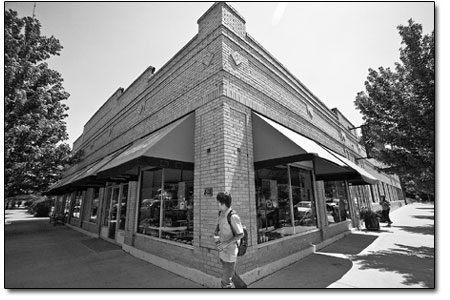| ||||
The evolution of arts
by Jules Masterjohn What is the role of a community arts center? This question is a hot topic these days, as the Durango Arts Center experiences growth pangs associated with the inevitable process of evolution. The new executive director, McCarson Jones, who came on board last week, inherits the organization’s long legacy as a visual arts center as well as its burgeoning performing arts programs. Rumblings of change began in 2007 when the Durango Melodrama needed a new home and the DAC Board of Directors began discussions to keep the traditional theater alive. In a dramatic departure from its historical role, the DAC bought the Melodrama, and its theater has become the stage for the highly regarded company. The next shake up came early this year when Brian Wagner departed from the organization after nearly 12 years as its executive director. Wagner saw the organization through an exponential expansion in its physical space, leading a $750,000 fund-raising effort toward the purchase of its new building. Initiated by his predecessor, Barbara Conrad, Wagner secured the permanent home for the arts in 1996, 30 years after its formation as a nonprofit organization. From a rented gallery location in the Main Mall to a 17,000-square-foot building on East Second Avenue, the Durango Art Center’s current location houses a theater, dance studio, conference room/library, rental offices, two art studios, a kitchen, a gift shop, and a main floor gallery. Along with more space came the possibilities for different offerings, and the organization grew into its new building. Responding to an increasingly child-centric and arts-interested society, the DAC incorporated after-school visual arts and musical theater into it’s programming in 2000. The theater also started serving as an event venue and has become a popular location for community happenings. More than 40 years after the seed of the organization took root to nurture and serve local visual artists, its branchings now reach out to include children and young people as well as the many performing arts. It all began around 1960, when a group of local visual artists got together to find venues to show their art. Marge Barge, now in her 70s and one of the founding members of the original art organization, recalls numerous exhibits in the Strater Hotel in those early days. Though not called the Durango Arts Center then, the organization was known as the heart of the visual arts, and in 1966, it incorporated as the nonprofit Durango Fine Arts Council and later came to operate under its current name. From unofficial accounts, the DAC conducted its business of visual art promotion out of at least five gallery locations on Main Avenue over 30 years (the official history compiled by Barge was lost among the many moves though scrapbooks have survived). In spite of moving headquarters every handful of years, it remained a vital and supportive force for local artists. Almost entirely volunteer-run, the DAC attracted artists to plan, curate and install exhibits, and it supported those individuals by bringing artists and appreciators together. Artist Karen Pittman remembered the early 1990s, saying, “The DAC was a great venue for people who were working on the cutting edge as well as creating representational work … and there was excellence in it all.” Not without its challenges, it appeared that the DAC was one not-so-big and relatively happy family.
Since its inception, DAC’s primary role had been as an exhibition venue for the visual arts, but it also began functioning as an incubator for initiatives in other art forms, nurturing efforts in film, dance, theater and music. In the mid-1980s, under director Leslie Sheiblberg, the DAC was a vital resource center for artists of all types, offering information and assistance with grant funding through the Colorado Council on the Arts. By the mid 1990s, director Conrad helped establish a grant program funded by the city of Durango to support local artists in all disciplines, which continues today. During his tenure, Wagner often stated that he was “serious about the ‘s’ in arts,” referencing the organization’s commitment to a broad range of art forms. Clearly, throughout its existence, the organization has been instrumental in stimulating growth in many art forms, which can be witnessed by our community’s rich offerings in local dance and theater, annual music festivals, and the emergence of Durango’s independent film festival. Today’s organization shows consistent advocacy for the performing arts and has grown in response to that infusion of energy. While this is seen as beneficial to those pursuing the performing arts, some artists are concerned that the visual arts are destined to become a stepchild within the organization. Others see the Melodrama as a positive presence, bringing hundreds of potential art buyers into the DAC gallery throughout the summer season: art sales will increase, they say. Still others disagree. There is debate among artists and art advocates as to the course the DAC might take to best continue its nurturance of artists and the visual arts. What does the future hold for visual artists within the DAC? How will diverse voices be heard and whose ideas implemented? When a nonprofit arts center becomes a sales venue, what impact does that have on commercial galleries? If the DAC were to serve all artists, what would that look like? Perhaps a few broader questions could be asked. As individuals, why do we create? What is the function of art in our society? What do we value about the arts? How does our exposure to various art forms and approaches to artmaking deepen our understanding of creativity and its role within society? What role do the arts play in the development of our human potential? These are but a few questions worth exploring as the DAC moves into the future. • Jules Masterjohn worked as the exhibits and program director at the Durango Arts Center from 1999-2004.
|



